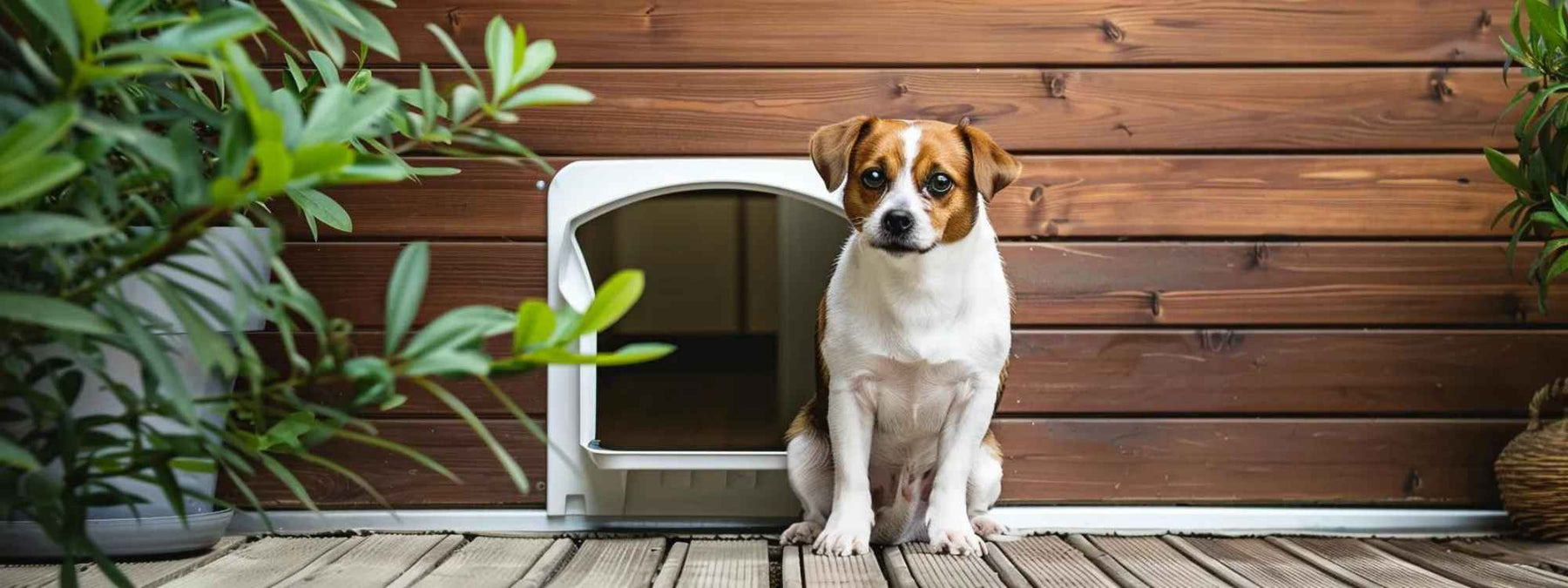737-215-3211

8 Alternative Dog Door Locations That Save Money on Remodeling
So, you're thinking about installing a dog door—but the thought of tearing open your wall or chopping into your brand-new back door isn't exactly appealing.
The standard spots for dog doors—front doors, back doors, or walls—can quickly become expensive headaches. Structural modifications, paint matching, drywall dust everywhere. Not exactly a fun weekend.
But what if I told you there are simpler, less invasive options you probably haven’t considered yet?
Because let’s face it, your dog already thinks they run the place. The least you can do is make their royal entryway a little easier on your wallet (and your sanity).
Here are eight clever spots for a dog door—no major remodel required.
1. Got a Garage? Here’s Why That Side Door Might Be Perfect
If your house has a garage, chances are there's a secondary garage door tucked away somewhere. You know the one—rarely opened, quietly waiting in the background. Turns out, it’s the perfect spot for a dog door.
Here's why:
Installing a pet door in your garage’s side entry is typically less expensive and far less messy than hacking into the main structure of your home. There's no need to break through drywall, insulation, or siding—just a straightforward modification to an existing door.
Plus, it creates a buffer zone. Your dog can shake off rain, mud, or snow before bounding into the living area. Less cleanup for you.

Just remember, garages can harbor chemicals, tools, or cars that aren't exactly pet-friendly. Use gates or barriers inside to guide your dog safely in and out.
2. Sneaking Through the Laundry Room? Don’t Overlook This Spot
If your laundry room sits at the back or side of your house, it might be hiding the perfect dog door location. It’s tucked away, low-traffic, and already designed for utility. That makes it a practical (and often cheaper) place to install a pet door.
Laundry rooms usually have doors or panels that are easier to modify than a main wall. Less drywall. Less framing. Less mess.
And there’s another upside. Your dog will come straight into a space designed for spills and dirt. Muddy paws? No problem. A washable mat or even a small rinse station can help keep the mess contained.
Just make sure nothing’s blocking the way—laundry baskets, machines, or detergent bottles could turn this shortcut into an obstacle course.
3. Sliding Glass Door Inserts: No Drilling Required
If you have a sliding glass door, there’s an easier way to add a dog door—without cutting into walls or hiring a contractor. It’s called a sliding glass door insert like PlexiDor Automatic Dog Door.
Here’s how it works: the insert fits right into the track of your existing sliding door. You slide it into place, lock it down, and you’re done. No drilling. No framing. And if you move or decide you don’t need it later, you can just remove it.
It’s a simple fix that doesn’t damage your home. Great if you’re renting. Or if you’re not ready to commit to a permanent hole in your wall.
There are a few trade-offs, though. The insert will shrink how wide the door opens. And you might need extra weatherstripping to seal out drafts.
4. Patio or Porch Access: Tapping into Outdoor Spaces
If you have a screened porch or covered patio, you might already have the perfect setup for a dog door—and not even realize it.
Using an existing porch or patio door means you won’t need to cut into the main exterior walls of your house. That alone can save you a lot of money (and hassle). Instead of going straight from the living room to the yard, your dog can move through the porch first.
It’s a natural flow. Out the porch door, into the yard. Simple.
This works especially well if your porch is already enclosed and secure. It creates a built-in buffer zone between your house and the outdoors. Less dirt. Fewer surprises.
You could also install a second pet door from the porch to the yard. Sometimes, two smaller dog doors are cheaper—and less invasive—than one big remodel.
Related: How To Install Dog Doors In A Door?
5. The Basement Walkout: An Overlooked Gateway
A basement walkout is a door that opens directly from the basement to the outside. It’s usually tucked around the side or back of the house—out of sight. But that’s what makes it useful. It keeps your dog’s comings and goings a little more private and out of the main traffic flow.
Since it’s already at ground level, it’s a natural exit point. And if the area is fenced, even better. Your dog gets outdoor access without tracking dirt through the main house.
There are a few things to keep in mind. Stairs—inside or outside—might be tricky for older dogs. A ramp could help.
Using this door also avoids cutting into upper-level walls, saving you from extra repairs, permits, and structural headaches upstairs.
6. A Side Entry or Utility Door: The Quiet MVP
If your home has a side entry or utility door—maybe near the kitchen, mudroom, or a mechanical room—it might be the best spot you’re not thinking about.
These doors aren’t front-and-center. Guests barely notice them. That’s a good thing. Less traffic. Less attention. And if you need to cut or replace one, it’s usually cheaper than altering a main entry or patio door.
It’s also practical.
Your dog gets quick access to the yard without tracking mud or dirt through your living room. Everything stays contained to one lower-traffic area.
If that side yard isn’t fenced, you could add a small enclosed run. It doesn’t have to be fancy—just enough to give your dog some freedom while keeping them safe.
7. Under a Stairwell: A Creative Indoor Solution
If you’ve got a stairwell with exterior access—or an enclosed landing near a side or back door—you might be sitting on a hidden gem.
It's a “secret” dog passageway tucked under the stairs. It’s out of sight, blends right into the structure, and doesn’t disrupt the main living areas. No need to cut into your kitchen or living room walls. Just make use of the space that’s already there.
It also opens up fun possibilities. You could create a small dog nook or crate area right next to the entrance. A cozy little zone that’s both functional and out of the way.
Before grabbing the saw, check what’s behind those walls. You don’t want to run into plumbing, wiring, or anything else hidden under there.
8. Through a Low Window: Not Just for Cats
Who says dog doors have to go in doors? If you have a ground-level window, you might already have an opening ready to go.
Instead of cutting into a wall, you can swap out a windowpane for a Lockable Dog Door Insert. It’s a clever way to use what’s already there—no reframing, no heavy construction.
There are some things to weigh, though. A window pet door can affect insulation. It might also need extra security measures, especially if the window faces a less private area.
One simple fix? Add a removable panel or an extra lock when the pet door’s not in use. That way, you keep things secure without losing convenience.
A Few Things to Think About
Before you start cutting or installing dog doors, it’s worth slowing down and asking a few key questions.
First, how will the weather affect this spot? A dog door that faces strong winds or heavy rain might need extra sealing—or it could let in more cold than you’d like.
Next, think about security. Could someone use the dog door to get inside? Some locations might need added locks or barriers to keep things safe.
Also, consider wear and tear. Is this a high-traffic area? Will muddy paws create more mess than you’re willing to clean?
Don’t forget your dog. Is the door low enough? Easy to reach? Stairs or steep drops can be tough for some pets.
And finally, ask yourself: will this change hurt resale value or make the house look odd?
Every home is different. What works in one space might not work in another. It’s all about finding the right balance between convenience, budget, and long-term practicality.
You Don’t Have to Tear Down a Wall for Your Puppy
When it comes to adding a dog door, you don’t need to reach for the sledgehammer. There are plenty of smart, budget-friendly ways to make it work—without ripping apart your home.
Sometimes, it’s about looking at your space a little differently. A side door here. A low window there. Small changes that save money while still giving your dog the freedom they want.
You don’t have to compromise on function or style. With the right spot, you can keep your house intact and your dog happy.
Every home is unique. Every dog is, too. But with a little creativity, you can find a solution that fits both.
Want more ideas for creating a safe, happy space for your dog? Take a look at our other blogs to keep learning about responsible dog care.






Leave a comment